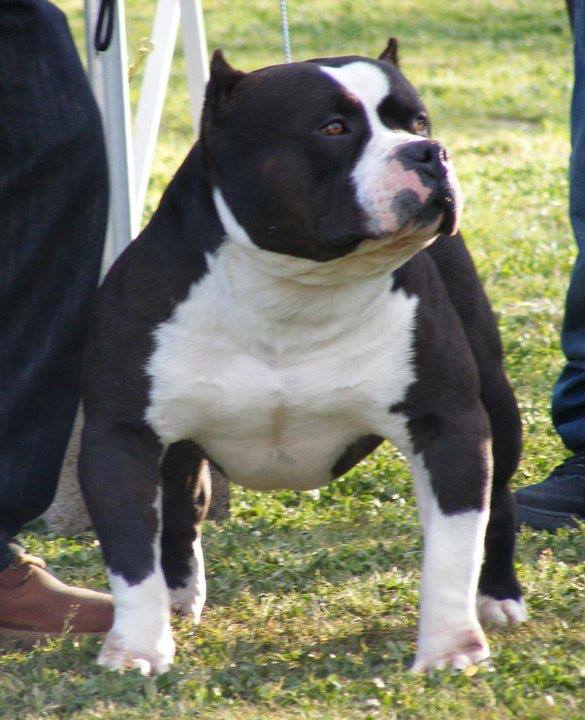AMERICAN BULLY

The American Bully has been around since approximately 2004 as a recognized breed. The first American Bullies were American Pit Bull Terriers (APBTs) and/or American Staffordshire Terriers (Amstaffs) that were beyond the “standard” set up for those breeds within the United Kennel Club (UKC) and American Kennel Club (AKC) respectively.
The American Bullies were cast out by those registries for not fitting their respective breed standards for the APBTs/AmStaffs. During this time period there were other breeds that were brought into the American Bullies that were not readily spoken about in the breed’s history which consists of the American Bulldog, English Bulldog, and Staffordshire Bull Terrier just to name a few that were added by certain bloodlines to enhance the look the breeders were trying to achieve above and beyond the original breed. Over the years the American Bully has begun to get a “desired” look that sets it apart from the other breeds, and is now a recognized breed by the UKC. The American Bully is a continuing breed that still to this day has various looks defined by bloodline, but with that said the American Bully look is starting to become more uniformed as the years have gone by.

GENERAL IMPRESSION
The American Bully should give the impression of great strength for its size, compact to medium/large size dog with a muscular body and blocky head. The American Bully should have the appearance of heavy bone structure with a bully build, the breed is a “head and front breed” chest should be wide to match blocky head type. The American Bully should NOT look like an APBT, Amstaff, or Exotic Bully.
Eliminating fault: viciousness or extreme shyness. Disqualification: Unilateral or bilateral cryptorchid (one or both testicles have not dropped).
HEAD
Medium length, deep through, broad skull, very pronounced cheek muscles, distinct stop, and high set ears.
EARS - High set and may be natural or cropped without preference. Prick, or flat, wide ears are not desired.
Disqualifications: Unilateral or bilateral deafness.
EYES - All colors except albinism. Eye shape would be round to oval, low down in skull and set far apart.
Serious Faults: Bulging eyes; both eyes not matched in color; blue eyes.
Disqualifications: blindness in either or both eyes not caused by injury.
USBR AMERICAN BULLY BREED STANDARD 2 JANUARY 2016
MUZZLE - Short-Medium rounded on upper side or slightly squared to fall away abruptly below eyes. Jaws well defined. Under jaw to be strong and have biting power.
LIPS - semi-close and even
BITE - scissor bite
NOSE - all colors acceptable.
FAULTS: Snipey muzzle; weak lower jaw.
SERIOUS FAULTS: Teeth or tongue showing when the mouth is closed.
NECK - Heavy, slightly arched, tapering from shoulders to back of skull-minimal or no loose skin.
Faults: Neck too thin or weak.
SHOULDERS - Strong and muscular with blades wide.
BACK - Fairly short to medium back. Slight sloping from withers to rump or straight accepted with gentle
short slope at rump to base of tail.
BODY – Massive, deep, and wide chest, deep in rear and all ribs close together. Forelegs set rather wide
apart to permit much chest development. Chest should be very deep and broad.
TAIL - Short to medium in comparison to size, low set, tapering to a fine point ending at the rear hock.
Faults: Kinks, knots, and short tails are also faults and accepted but not preferred in the show ring.
Eliminating fault: Curled, docked, and/or twisted tails
LEGS:
Front legs - straight front legs, Large and round bones, pasterns upright are preferred.
Fault: Weak pasterns
FEET: No Standard
USBR AMERICAN BULLY BREED STANDARD 3 JANUARY 2016
Should be of moderate size and compact.
A slight turning outwards of the feet up to 15 degrees is accepted.
Faults: Feet measuring between 15 and 45 degrees are accepted but not preferred.
Serious fault: Feet measuring between 45 and 90 are accepted but considered a serious fault.
Disqualification: Feet measuring beyond 90 degrees when stacked are disqualifying.
HINDQUARTERS - The hindquarters are strong, muscular, and broad. The rump is well filled in on
each side of the tail and deep from the pelvis to the crotch. The bone, angulation, and musculature of the
hindquarters are in balance with the forequarters. The thighs are well developed with thick, easily discerned
muscles. Viewed from the side, the hock joint is well bent and the rear pasterns are well let down and
perpendicular to the ground. Viewed from the rear, the rear pasterns are straight and parallel to one another.
Faults: Narrow hindquarters; hindquarters shallow from pelvis to crotch; lack of muscle; straight or over
angulated stifle joint, cow hocks, and sickle hoc.
GAIT - Should be effortless and powerful. The action must, however, be unrestrained, free and vigorous with
powerful drive off the rear. Some paddling and lumber accepted
COAT - The coat is glossy and smooth, close, and moderately stiff to the touch.
Faults: Curly hair
Disqualification: Long coat.
COLOR - All colors and patterns are accepted except the color merle.
Disqualification: the color merle
SIZE:
Height and weight should be in proportion to the dog and measured from the withers.
- Varieties
-- Pocket: Male: 16” and under; Females: 15” and under
-- Standard: Male: 16”-19”; Female 15”-18”
-- XL: Male: 19” and over; Females 18” and over
-- Extreme has no height requirement. Extreme is a description of features in proportion to the dogs height and
weight; i.e. bone mass, mass, head size, chest, etc...
USBR AMERICAN BULLY BREED STANDARD 4 JANUARY 2016
MISCELLANEOUS - There are no weight limitations or requirements for the breed, but dogs should
not be obese and should be able to move freely.
Faults:
Bulging eyes
Both eyes not matched in color
Blue eyes
Tails with kinks and/or knots
Short tails that do not reach the hock
Long tails that go beyond the hock
Undershot or overshot mouths
Snipey muzzle
Weak lower jaw
Teeth or tongue showing when the mouth is closed
Severe turned fronts
Front feet that are between 15 and 90 degrees
Neck too thin or weak
A coat with curly hair
Weak pasterns
Narrow hindquarters
Hindquarters shallow from pelvis to crotch
Lack of muscle
Straight or over angulated stifle joint
Cow hocks and sickle hock
Aggressive behavior towards animals and humans.
Eliminating fault: (A dog with an Eliminating Fault is not to be considered for placement in a conformation
event, nor are they to be reported to USBR.)
Curled, docked, and/or twisted tails
Viciousness or extreme shyness
Disqualifications: (A dog with a disqualification must not be considered for placement in a conformation event, and its registration number must be reported to USBR.)
Unilateral or bilateral cryptorchid (one or both testicles have not dropped)
Albinism
Merle
Blindness in one or both eyes not caused by injury
Unilateral or bilateral deafness
Feet beyond 90 degrees when stacked
Long coat








